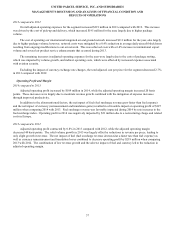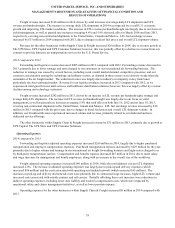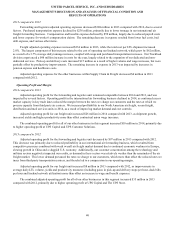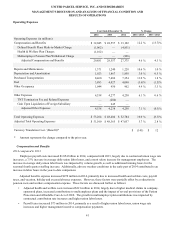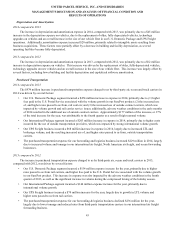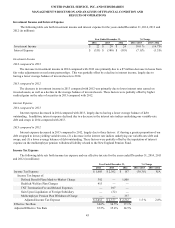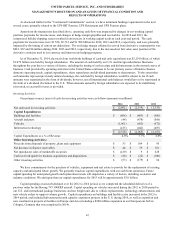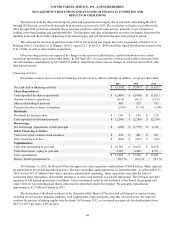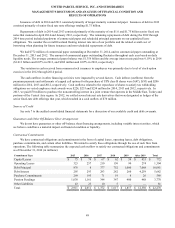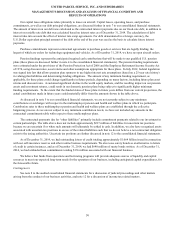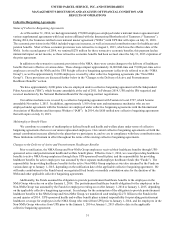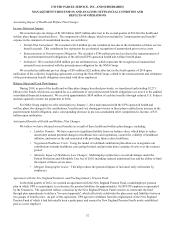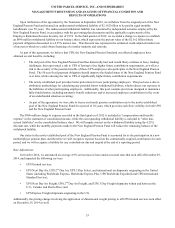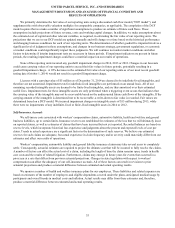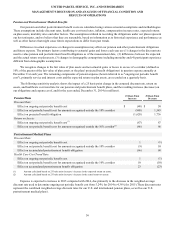UPS 2014 Annual Report Download - page 59
Download and view the complete annual report
Please find page 59 of the 2014 UPS annual report below. You can navigate through the pages in the report by either clicking on the pages listed below, or by using the keyword search tool below to find specific information within the annual report.
UNITED PARCEL SERVICE, INC. AND SUBSIDIARIES
MANAGEMENT'S DISCUSSION AND ANALYSIS OF FINANCIAL CONDITION AND
RESULTS OF OPERATIONS
47
As discussed further in the “Contractual Commitments” section, we have minimum funding requirements in the next
several years, primarily related to the UPS IBT Pension, UPS Retirement and UPS Pension plans.
Apart from the transactions described above, operating cash flow was impacted by changes in our working capital
position, payments for income taxes, and changes in hedge margin payables and receivables. In 2014 and 2013, the
compressed holiday shipping season resulted in an increase in working capital needs at each year-end period. The cash
payments for income taxes were $1.524, $2.712 and $1.988 billion for 2014, 2013 and 2012, respectively, and were primarily
impacted by the timing of current tax deductions. The net hedge margin collateral received from derivative counterparties was
$421, $67 and $4 million during 2014, 2013 and 2012, respectively, due to the increased net fair value asset position of the
derivative contracts used in our currency and interest rate hedging programs.
As of December 31, 2014, the total of our worldwide holdings of cash and cash equivalents was $2.291 billion, of which
$1.072 billion was held by foreign subsidiaries. The amount of cash held by our U.S. and foreign subsidiaries fluctuates
throughout the year due to a variety of factors, including the timing of cash receipts and disbursements in the normal course of
business. Cash provided by operating activities in the United States continues to be our primary source of funds to finance
domestic operating needs, capital expenditures, share repurchases and dividend payments to shareowners. To the extent that
such amounts represent previously untaxed earnings, the cash held by foreign subsidiaries would be subject to tax if such
amounts were repatriated in the form of dividends; however, not all international cash balances would have to be repatriated in
the form of a dividend if returned to the U.S. When amounts earned by foreign subsidiaries are expected to be indefinitely
reinvested, no accrual for taxes is provided.
Investing Activities
Our primary sources (uses) of cash for investing activities were as follows (amounts in millions):
2014 2013 2012
Net cash used in investing activities $ (2,801)$(2,114)$(1,335)
Capital Expenditures:
Buildings and facilities $ (808)$ (483)$ (506)
Aircraft and parts (44)(478)(568)
Vehicles (1,061)(662)(672)
Information technology (415)(442)(407)
$(2,328)$(2,065)$(2,153)
Capital Expenditures as a % of Revenue 4.0% 3.7% 4.0%
Other Investing Activities:
Proceeds from disposals of property, plant and equipment $ 53 $ 104 $ 95
Net decrease in finance receivables $ 44 $ 39 $ 101
Net (purchases) sales of marketable securities $ (419) $ 9 $ 628
Cash received (paid) for business acquisitions and dispositions $ (88)$ (22)$ (100)
Other investing activities $ (63)$ (179)$ 94
We have commitments for the purchase of vehicles, equipment and real estate to provide for the replacement of existing
capacity and anticipated future growth. We generally fund our capital expenditures with our cash from operations. Future
capital spending for anticipated growth and replacement assets will depend on a variety of factors, including economic and
industry conditions. We anticipate that our capital expenditures for 2015 will be approximately $3.0 billion.
Capital spending on aircraft declined over the 2012 to 2014 period, as we completed the scheduled deliveries of a
previous order for the Boeing 767-300ERF aircraft. Capital spending on vehicles increased during the 2012 to 2014 period in
our U.S. and international package businesses and our freight unit, due to vehicle replacements, technology enhancements and
new vehicle orders to support volume growth. Capital expenditures on buildings and facilities also increased in the 2012 to
2014 period, and included hub automation and capacity expansion projects in the U.S. during 2014, as well as expansion and
new construction projects at facilities in Europe and Asia (including a $200 million expansion at our European air hub in
Cologne, Germany that was completed in 2014).


